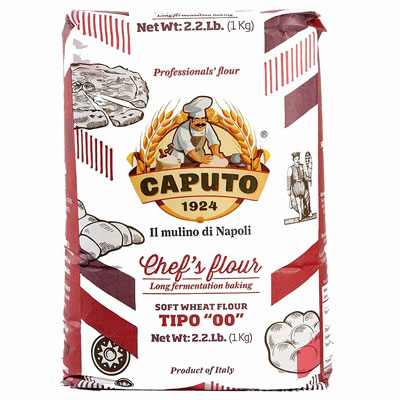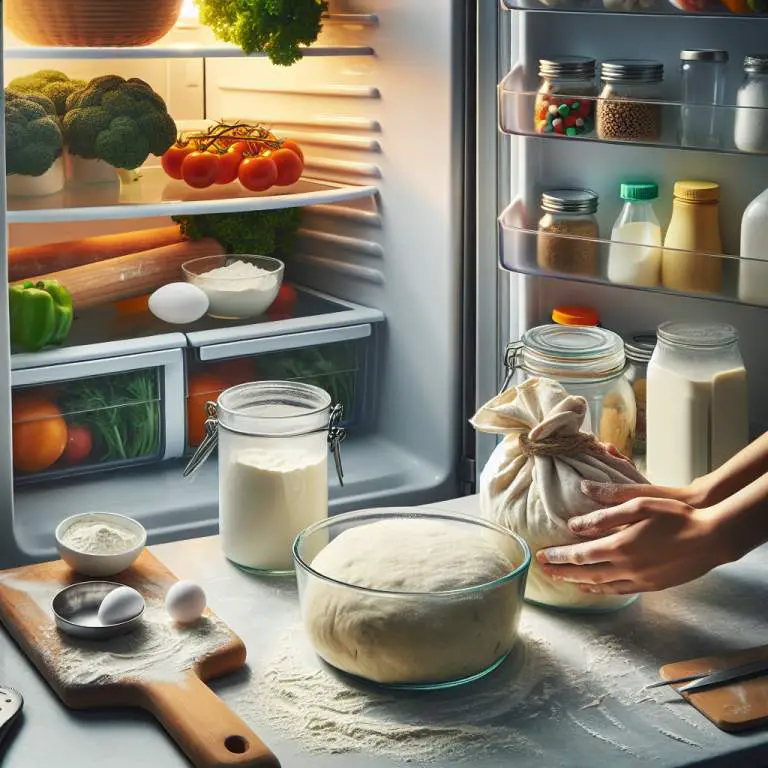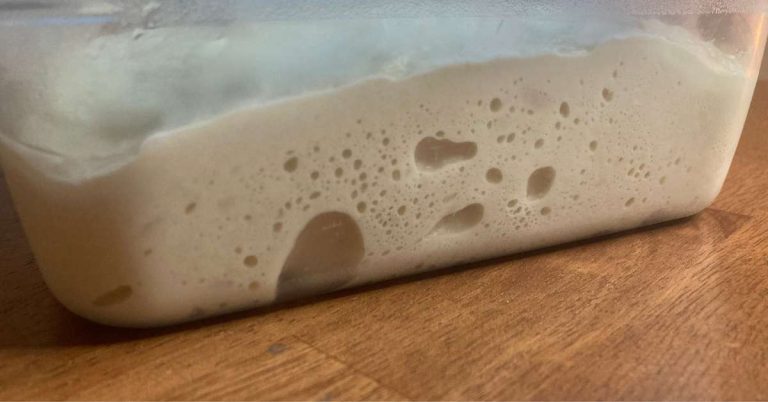80% Hydration Pizza Dough Recipe – Fluffiest Pizza Crust Ever
This 80% hydration pizza dough recipe will give you the fluffiest, moistest pizza dough you can make right at home. This recipe is perfect for making authentic style pizza crust that won’t dry out in a home oven. 80% is just about the highest hydration level you’re going to find in a pizza dough recipe. In fact, it’s so high I choose to let it rest overnight rather than knead it.
Tip: If this is your first time working with pizza dough, you might find that 80% hydration is too sticky and wet. For something a little bit easier, try my 70% hydration pizza dough recipe instead.
What Kind Of Flour Do You Use To Make Pizza Dough?
Because this recipe deals with so much water, you need a flour with high absorbability. This basically refers to how much water each grain of flour can absorb before it becomes saturated.
If you try to make this recipe using a low absorption flour, like many 00 flours branded as “pizza flour” are, the dough will more closely resemble a soup than a pizza dough.
For an 80% hydration pizza dough, I recommend using Caputo’s “Chef’s Flour” or a high quality all-purpose flour like King Arthur’s. Both of these flours will be able to handle excessive moisture without any problems.
These flours are easily purchased online, but any kind of all-purpose flour should work as well.
Related Post: Why 00 Flour Is Best For Pizza: What It Is & How It Makes A Difference

80% Hydration Pizza Dough
Ingredients
- 275 g Caputo Chef’s 00 or All Purpose Flour (2.2 cups)
- 220 g Water (1 cup)
- 8.5 g Salt (1/2 tablespoon)
- 1/8 tsp Active Dry Yeast
- 3 tbsp Extra Virgin Olive Oil
- 1 tbsp Honey
Instructions
- Measure the water, yeast and honey into a mixing bowl. Use lukewarm water, not hot or ice cold.
- Measure the flour and salt into another bowl.
- Slowly incorporate the dry ingredients into the water mixture a few scoops at a time. It’s important to make sure all of the flour is completely hydrated by the water.
- When 50% of the flour is mixed into the water, add olive oil and mix it in thoroughly.
- Add the rest of the flour, cover the bowl and let it sit for 10-20 minutes.
- Come back and give the dough a final mixing. You’ll notice that the texture of the dough is much smoother.
- Transfer the dough to a plastic container with a lid and let is sit at room for 11-18 hours. During this time the gluten network will mature and the fermentation process will begin.
- When the dough is ready it will be roughly 2-3x the size.
- Refrigerate the dough for several hours to slow fermentation and make it easier to work with later.
- Divide the dough into two 250 gram pieces of dough, or leave it as one 500 gram piece for a larger pizza.
- Shape the pieces into tight dough balls and let them proof at room temperature before using. Otherwise, store them in the fridge for extra fermentation.








What Percent Hydration Should Pizza Dough Be?
The higher the hydration level of a dough, the more moisture it will retain after being baked.
In a wood-fired oven, pizza only needs around 90 seconds before it’s completely cooked and charred on the outside. That’s because wood-fired ovens often reach up to 900F. For this reason, pizza dough made for this kind of an oven usually only needs around 55%-65% hydration.
In a regular home oven, a pizza might need 10 minutes or more before it’s completely cooked. This means by the time it’s done your crust will be brittle and dry, unlike the crispy on the outside and tender in the middle crust you find at professional pizzerias.
In a home oven, pizza dough should be between a 70 and 80 percent hydration level. This ensures that the crust retains some moisture during the long cooking process. 80 percent is the maximum recommended hydration level for pizza dough.
When Will The Pizza Dough Be Ready?
This recipe follows the no-knead methodology pioneered by Jim Lahey many years ago. That means you’ll mix the ingredients until all the flour is hydrated into the water and then let it sit for 11-18 hours while the gluten network matures. You can knead it if you want but 80% hydration makes working with the dough extremely difficult by hand.
Related Posts:
- 70% Hydration Pizza Dough Recipe – No More Dry Crust
- Domenic’s Detroit Style Pizza Dough Recipe (no-knead)
- Improved Ooni Pizza Dough Recipe: 65% Hydration, Double Fermented, No-Knead Method
- Pepperoni and Jalapeno Pizza – Tastiest Pizza Ever
- How To Make Neapolitan Pizza Dough – 2021 Home Oven Recipe
Related Questions:
What Is The Ratio Of Flour To Water For Pizza Dough?
The ratio of flour to water in pizza dough can vary quite a bit from recipe to recipe. For a high hydration recipe, you’ll find 700-800 grams of water for every 1000 grams of flour. For a lower hydration recipe, you’ll find 500-600 grams of water for every 1000 grams of flour.
Can You Let Pizza Dough Rise Too Long?
If you let pizza dough rise too long at room temperature, the yeast will produce too much alcohols and acids as it converts all the starches into sugar. This makes for a pizza dough with a sour taste and poor texture. For better results, it’s preferable to let your pizza dough cold ferment in a refrigerator for several days. This slows down the yeast activity and yields a complex taste similar to sourdough.
Is Pizza Dough Low Or High Hydration?
Pizza dough can either be high or low hydration depending on its intended use. For pizza that will be cooked fast in a wood fired oven, it’s better to use a low hydration dough. For pizza that will be cooked slow in a lower temperature home oven, it’s better to use a high hydration dough. This is because the longer a pizza dough is cooked the more moisture it loses to evaporation.









This 80% hydration pizza dough recipe is perfect for all your home oven pizza making needs. Have you tried it? Remember if you find this dough too wet to work with, you can try my 70% pizza dough linked in the post above.
Let me know if you have any questions or comments!
Hi, Domenic. My question is at what temp and for how long do you cook the pizzas? I’ve tried 550 and par-baking at 550. The par-baking worked only around the outside inch. I pulled it when things started browning. Everything else is undercooked. Thanks in advance.
Hey Joseph. In a home oven, you should be baking at the maximum temperature, so 550F should be fine. My home oven barely hits 500F and it gives me a beautiful golden brown crust every time.
It sounds like you’re either not using a baking stone or the baking stone hasn’t been preheated for long enough. Ideally, you should be seeing small brown spots appear on both the outside inch and the underside of the crust after around 5 minutes of par baking. This is my signal to take the crust out and top it with cheese (and sauce if you par-baked it plain). Put it back in the oven until the cheese starts to bubble and by then the underside of the crust should be a deep golden brown color.
Also, make sure your stone is hot enough before you par-bake the crust. Depending on the stone and your oven, it can take anywhere from 1-2 hours to reach the right temperature, otherwise the underside of the crust won’t brown.
Good luck!
I do a 70% hydration using my home oven at 550 degrees for around 7 minutes. I use a stone, and preheat for around 45 minutes. I use the second from the bottom rack, and i switch to broil for 10 mins before sliding the pizza on the stone. it’s beautiful every time. If I use my pizza oven outside, it’s around 900 degrees and i use a 65% hydration and it takes around 2 minutes…turning it after 45 seconds, every 20 seconds or so. I also use blue label caputo flour and a malted syrup of around 2% with 2% salt. I use a poolish as well, for 8 hours at room temperature, than overnight in the fridge.
Thanks for sharing your techniques with us, Martin, your pizza sounds amazing. You obviously know what you’re doing!
Have you tried using a pizza steel? I bet your crust would come out even better. All the best to you!
I used this over the weekend for a pan pizza and it turned out great. This is easily one of the best pizza dough recipes I’ve tried. The crust was almost sweet tasting after fermenting it for a few days like you suggested.
I’d love to use this for a traditional pizza using my pizza stone, but I’m afraid of a dough this wet sticking to the peel. Would oiling the peel help like it does when using a pan? All the best.
Hey, Mary. Glad to see the recipe worked out well for you. As for your question, you should NEVER put oil on a pizza peel. To prevent sticking, it’s always best to use flour. I recommend dropping the proofed dough ball into a semolina flour bath and thoroughly coating all sides. This should be enough to prevent it sticking to your hands as you shape it and the peel as you slide it into the oven. Good luck!